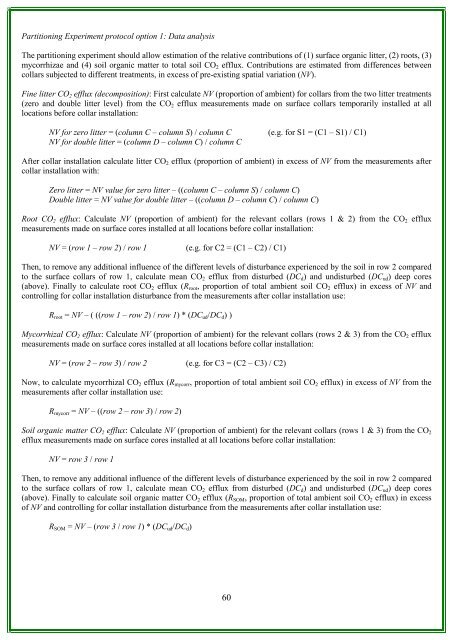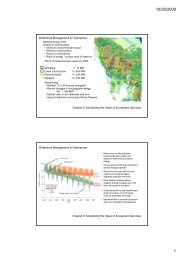RAINFOR GEM Intensive Plots Manual (pdf) - University of Oxford
RAINFOR GEM Intensive Plots Manual (pdf) - University of Oxford
RAINFOR GEM Intensive Plots Manual (pdf) - University of Oxford
- No tags were found...
You also want an ePaper? Increase the reach of your titles
YUMPU automatically turns print PDFs into web optimized ePapers that Google loves.
Partitioning Experiment protocol option 1: Data analysisThe partitioning experiment should allow estimation <strong>of</strong> the relative contributions <strong>of</strong> (1) surface organic litter, (2) roots, (3)mycorrhizae and (4) soil organic matter to total soil CO 2 efflux. Contributions are estimated from differences betweencollars subjected to different treatments, in excess <strong>of</strong> pre-existing spatial variation (NV).Fine litter CO 2 efflux (decomposition): First calculate NV (proportion <strong>of</strong> ambient) for collars from the two litter treatments(zero and double litter level) from the CO 2 efflux measurements made on surface collars temporarily installed at alllocations before collar installation:NV for zero litter = (column C – column S) / column C (e.g. for S1 = (C1 – S1) / C1)NV for double litter = (column D – column C) / column CAfter collar installation calculate litter CO 2 efflux (proportion <strong>of</strong> ambient) in excess <strong>of</strong> NV from the measurements aftercollar installation with:Zero litter = NV value for zero litter – ((column C – column S) / column C)Double litter = NV value for double litter – ((column D – column C) / column C)Root CO 2 efflux: Calculate NV (proportion <strong>of</strong> ambient) for the relevant collars (rows 1 & 2) from the CO 2 effluxmeasurements made on surface cores installed at all locations before collar installation:NV = (row 1 – row 2) / row 1 (e.g. for C2 = (C1 – C2) / C1)Then, to remove any additional influence <strong>of</strong> the different levels <strong>of</strong> disturbance experienced by the soil in row 2 comparedto the surface collars <strong>of</strong> row 1, calculate mean CO 2 efflux from disturbed (DC d ) and undisturbed (DC ud ) deep cores(above). Finally to calculate root CO 2 efflux (R root , proportion <strong>of</strong> total ambient soil CO 2 efflux) in excess <strong>of</strong> NV andcontrolling for collar installation disturbance from the measurements after collar installation use:R root = NV – ( ((row 1 – row 2) / row 1) * (DC ud /DC d ) )Mycorrhizal CO 2 efflux: Calculate NV (proportion <strong>of</strong> ambient) for the relevant collars (rows 2 & 3) from the CO 2 effluxmeasurements made on surface cores installed at all locations before collar installation:NV = (row 2 – row 3) / row 2 (e.g. for C3 = (C2 – C3) / C2)Now, to calculate mycorrhizal CO 2 efflux (R mycorr , proportion <strong>of</strong> total ambient soil CO 2 efflux) in excess <strong>of</strong> NV from themeasurements after collar installation use:R mycorr = NV – ((row 2 – row 3) / row 2)Soil organic matter CO 2 efflux: Calculate NV (proportion <strong>of</strong> ambient) for the relevant collars (rows 1 & 3) from the CO 2efflux measurements made on surface cores installed at all locations before collar installation:NV = row 3 / row 1Then, to remove any additional influence <strong>of</strong> the different levels <strong>of</strong> disturbance experienced by the soil in row 2 comparedto the surface collars <strong>of</strong> row 1, calculate mean CO 2 efflux from disturbed (DC d ) and undisturbed (DC ud ) deep cores(above). Finally to calculate soil organic matter CO 2 efflux (R SOM , proportion <strong>of</strong> total ambient soil CO 2 efflux) in excess<strong>of</strong> NV and controlling for collar installation disturbance from the measurements after collar installation use:R SOM = NV – (row 3 / row 1) * (DC ud /DC d )60





